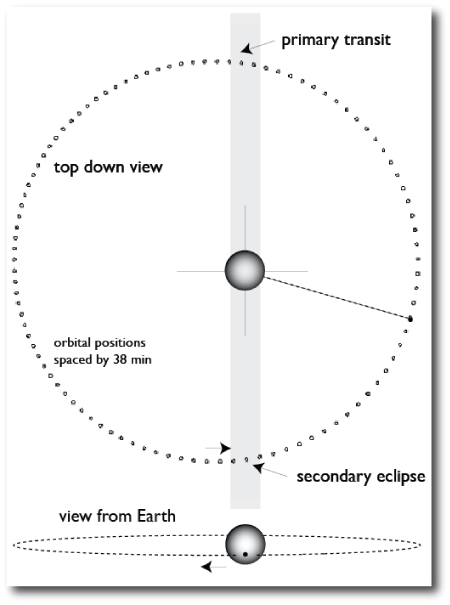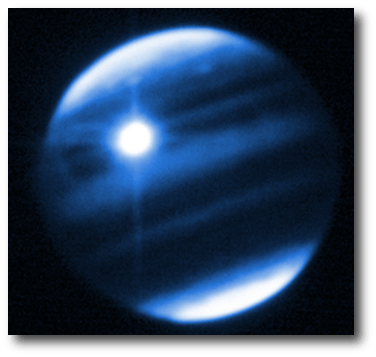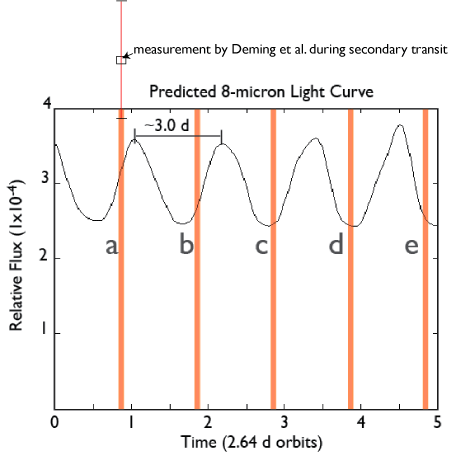
Image Source.
As I write this, it’s JD 2454425.219 (17:16 UT, Nov. 20 2007). HD 80606 b whipped through periastron a little more than 10 hours ago, and the Spitzer Space telescope is literally just finishing its 31-hour observation of the event. Next comes the downlink of the data to Earth on the Deep Space Network, and then the analysis. Definitely exciting!
The Spitzer Space Telescope is scheduled to run out of cryogen in early 2009. When the telescope heats up, we’ll lose our best platform for mid-infrared observations of hot extrasolar planets, and so there was a palpable urgency last week as everyone prepared their proposals to meet the submission deadline for Spitzer’s last general observing cycle. During the next few years, there is going to be intense development of detailed 3D radiation-hydrodynamical models for simulating the time-dependent surface flows on extrasolar planets. These models will need contact points with hard data. It’s thus vital to bank as wide a variety of observations of as wide a variety of actual planets under as wide variety of different conditions as possible. A number of fascinating exoplanet observing proposals were submitted last week by a variety of highly competent teams. I’m urging that they all be accepted!
Most of the exoplanet observations that have been done with Spitzer have focused on tidally locked transiting planets on circular orbits. HD 189733b, HD 209458b, TrES-1 and HD 149026b are the flagship examples of this class. In the past year, however, eccentric transiting planets have started turning up. Gliese 436b (e=0.15) was the first, followed by HAT-P-2b (e=0.5), and HD 17156b (e=0.67).
Drake Deming, Jonathan Langton and I decided that the most interesting proposal that we could make would be for Gliese 436 b. This is the Neptune-mass, Neptune-sized planet transiting a nearby red dwarf star. Here’s the to-scale diagram of the 2.644-day orbit:

After Gliese 436b was discovered to transit last spring, it triggered a Joe Harrington’s standing Target of Opportunity program. Both a primary and a secondary transit were observed (see this post) which confirmed the startlingly high eccentricity, and which allowed an estimate of the planet’s temperature (or, more precisely, the 8-micron brightness temperature). This turned out to be 712±36 K, which is significantly higher than the ~650 K baseline prediction.
The hotter-than-expected temperature measurement could arise from a number of different effects (or combinations of effects). By measuring the secondary eclipse, you strobe one hemisphere of the planet. If there are significant temperature variations across the surface of the planet, then a high reading might arise from chancing on the hotter side of the planet. Alternately, the effective temperature implied by measuring the energy coming out at 8-microns could be seriously skewed if the spectrum of the planet has deep absorption or emission bands at the 8-micron wavelength. Another possibility is that we’re observing tidal heating in action. Gliese 436b is being worked pretty hard in its eccentric orbit, and it should be generating quite a bit of interior luminosity as a result. If its structure is similar to Neptune, then a 712K temperature is completely understandable.
Io, of course, is subject to a similar situation. Here’s a K-band infrared photo of Io in transit in front of Jupiter:

Image Source.
Gliese 436b is in pseudo-synchronous rotation, and spins on its axis every ~2.3 days. The eccentricity of the orbit leads to an 83% variation in the amount of light received from the star over a 1.3 day timescale. This leads to a complicated flow pattern on the surface.
Here’s what Jonathan Langton’s model predicts for the appearance of the hemisphere facing Earth at five successive secondary eclipses:

Globally, the hydrodynamical model produces a statistically steady-state flow pattern that is dominated by a persistent eastward equatorial jet with a zonally averaged speed of ~150 meters per second. This eastward flow in the planet’s frame produces a light curve in the lab frame that has a ~3 day periodicity. This period is significantly longer than both the planet’s orbital period and the planet’s spin period. Our Spitzer proposal is to observe a sequence of 8 secondary transits in hopes of confirming both the amplitude and the periodicity of this light curve.

It’s certainly the case that our current hydrodynamical model is not the definitive explanation of what these planets are doing. I won’t be at all surprised if the flux variation from eclipse to eclipse is more complicated than what we predict. I’m highly convinced, however, that the model is good enough to indicate that the situation on Gliese 436b will be interesting, dynamic, and complex. The actual variation in the real observations will provide an interesting and non-trivial constraint that a definitive model of the planet will need to satisfy. The observations, if approved, will thus be of great use to everyone in the business of constructing GCMs for short period planets.
Stay tuned…

Hi Greg,
any news on the HAT-P-2b data ?
Cheers,
Luis
Luis,
The reductions of the HAT-P-2b data will be finished fairly soon…
best,
Greg